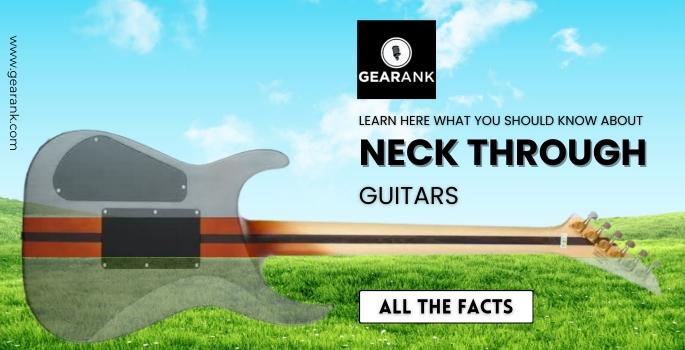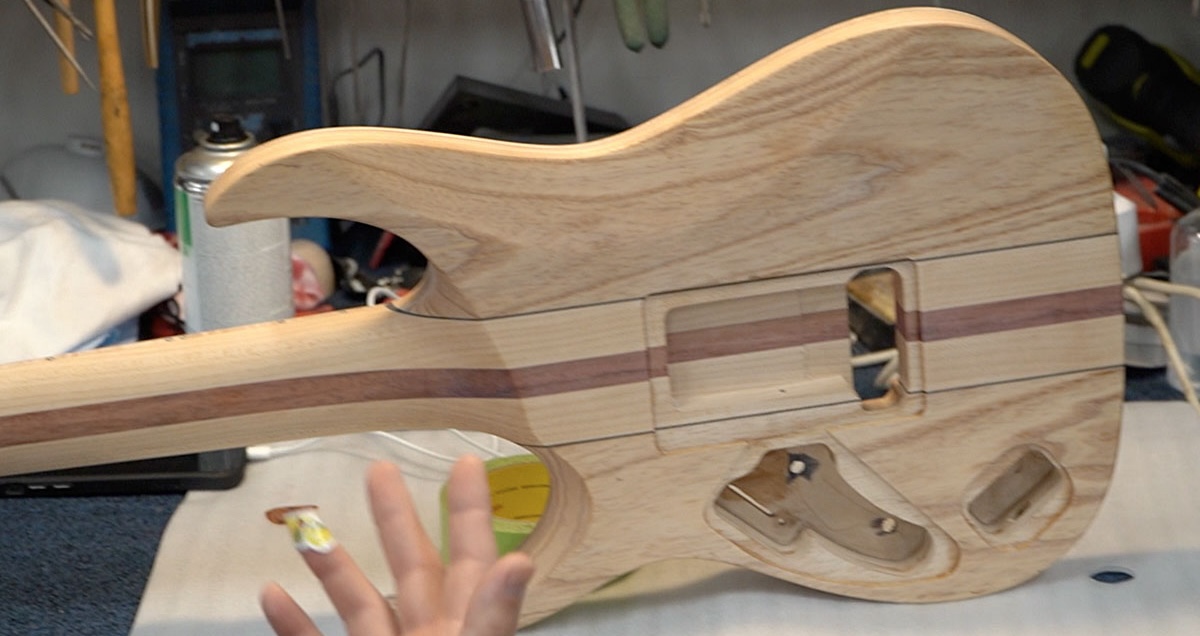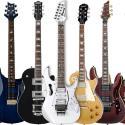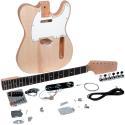Neck Through Guitar vs. Bolt On vs. Set Neck

Do you want to know what makes a neck-through guitar special? How is it different from a bolt-on guitar and a set-neck guitar?
If you're curious about how these neck joints work, this article is for you.
You'll learn
-
What is a Guitar Neck Joint?
-
What is a Neck Through Guitar?
-
What are Bolt-on Neck Guitars?
-
What are Set Neck Guitars?
-
Neck Joints Shootout
-
Common Misconceptions About Neck Joints
So, if this piques your interest, let's begin!
What is a Guitar Neck Joint?
A guitar neck joint, or neck-to-body joint, refers to the connection point of a guitar's neck and body. This is a crucial guitar component that serves structural and tonal functions.
This article focuses on the neck through joint, but we will also touch on the other two common neck joints: bolt-on and set-neck.
What is a Neck Through Guitar?
Origin
Neck-through guitars go back as early as the 1930s, when the first electric bass guitar by Paul Tutmarc, the “Audiovox 736,” was made.
Later, in 1941, a version of a neck-through for electric guitars was made by Les Paul called “The Log”. This model is considered to be the predecessor of modern neck-through electric guitars.
Then, in 1956, Rickenbacker contributed to popularizing these types of neck joints on guitars as one of the first to manufacture them. To this day, they still offer neck through models like the Model 650C Colorado.
Structure

Neck-throughs, AKA neck thru guitars, are electric guitars where the neck runs through the guitar body all the way to the bottom end of the instrument.
On the sides of the body are two slabs of wood glued to the neck slab, known as "wings." These wings form the main shape of the body.
Feel and Playability
Because of its one-piece construction, a neck-through guitar doesn’t need screws. As a result, the “heel” in a neck-through guitar can be trimmed or shaved off, facilitating better upper fret access.
So, if you’re a shredder and like to operate on the higher frets, this guitar would surely feel fantastic.

Durability
A neck-through guitar can use a single piece of wood or laminate different pieces of wood together, creating a single neck.
This makes for a sturdier instrument compared to its bolt-on or set-neck counterparts. It's also less prone to warping.
This type of neck joint is common in bass guitars because basses require a stronger body to hold their massive strings.
Tone
Basically, the strings in a neck-through guitar are tied down on the same piece of wood (from the headstock to the bridge). This type of construction enables energy transfer from the neck to the bridge unhindered as it travels a straight path, which makes sense.
Because of its unique build, this neck joint (arguably) resonates better than the other two.
Price
On the flip side, these neck-through guitars are usually expensive to build because of their complex construction.
You would also run the risk of buying an entirely new guitar if you somehow broke its neck. While neck-through guitars are durable, they aren't immune to chips, dings, or even breaking. And if these bad things happen, there's no way to replace the neck since it cannot be separated from the body. This means high repair costs, sometimes as much as buying a brand new one.
Manufacturers
There are plenty of manufacturers today that are producing neck-through guitars. Companies like Jackson, ESP, Schecter, Ibanez, PRS, Rickenbacker, BC Rich, Parker Guitars, Alembic, Carvin, ESP, Cort, Yamaha, as well as Gibson which uses this neck joint on their Firebird and Thunderbird models.
Other Types of Neck Joints
What are Bolt-on Neck Guitars?

Bolt-on neck guitars, or simply bolt-on guitars, refer to a guitar with two main components (the neck and the body) joined by screws, or "bolts".
This type of neck-body joint is very common and is the cheaper option compared to a neck thru. The reason is not because of the quality but the structure.
As I previously mentioned, bolt-on necks are screwed together. Meaning that it's not permanently attached to the body. So, if the neck or body breaks down, it can easily be replaced or swapped for a new one.
What are Set Neck Guitars?

In a set neck guitar, the neck is glued together to the body. This makes for a more permanent positioning, while still having the neck separate from the body.
Most set necks like the Les Paul guitar can easily be identified as having a dovetail. This type of neck joint construction is known for providing good resonance and sustain.
This neck joint is widely used on acoustic guitars.
Neck Joints Shootout
PROS And CONS
Neck Through
-
Better fret access - Generally Expensive Price
-
Stable/Less prone to neck warping - Most expensive and complicated to repair
-
Better craftsmanship - Fixed joint means no way to change the neck
-
Aesthetically pleasing - May not appeal to fans of classic guitar designs
Bolt-On
-
Cost-effective - Obstructive heel & neck plate (most models)
-
Versatile (easy neck swapping) - More prone to neck bending/warping
-
Easy to maintain and replace - Not as reliable as the other types
Set Necks
-
Stable - Expensive to repair
-
Aesthetically pleasing - Difficult to make adjustments
-
Can be replaced and maintained - Moderate reliability
-
Obstructive heel design
Clarifications:
Upper Fret Access
Indeed, neck-throughs are generally better than bolt-ons and set-necks when it comes to upper fret access. But some bolt-on and set-neck models feature ergonomic heels which allow for better neck to body transition.
These newer iterations allow easy access to the upper frets, but still not as smooth as a genuine neck through guitar.
Durability
Neck-throughs are considered superior when it comes to durability, but the other neck types are not too far behind. Durability is more reliant on build quality and the strenght of materials than the neck joint type. You can also make the case that bolt-on and set-necks are easier to maintain, which allows for longer use.
Tone and Sustain
Logically, a continuous piece of wood will be more resonant than multiple pieces of wood combined together. But the difference is probably minuscule, there have been studies that show tight bolt-on necks with no air pockets have similar resonance to a neck thru.
Or particular interest is this study on Sustain and Electric Guitar Neck Joint Type, which shows bolt-on necks having longer sustain over the other types.
Note that resonance and sustain due to neck joint are but small parts of the overall electric guitar tone. I would argue that it plays a minor role compared to the strings, pickups, pedals, and amps.
Price
The more complex the guitar build, the pricier the guitar gets. So generally speaking, a neck through guitar would be pricier. But there are other bigger factors that affect the price, including the guitar makers (brand), build quality, tonewoods and hardware.
Final Thoughts
A Neck-through guitar is an incredible instrument to behold - but it requires a serious investment.
Its seamless design and durability make it a great choice over the usual bolt-on and set-neck guitars.
Just remember to handle and care for them properly because any damage to the neck will be costly
If you find yourself often playing at the upper frets, and you have the budget, then a neck-through guitar is going to be fantastic for you.
Frequently Asked Questions
What are Signs that a Neck Needs Repairs?
Visually, you can see if it has cracks, separations, or splits. By viewing the neck from the top, you can also see if it's warped and from the side if it has high action, both are symptoms of a faulty neck.
A damaged neck would also sound bad, cause fret buzz and unstable tuning, and make it difficult for you to play overall.
How to Change Guitar Necks?
Changing guitar necks can be as simple as attaching a different neck for bolt-on guitars. But, it won't be as easy if you have a set neck guitar. It would even be close to impossible for or a neck thru model. Best consult with a professional luthier if you encounter major neck issues.
How to Maintain Guitar Neck Joints?
What you can do is store your instrument away from a humid environment. Make sure your guitar's truss rod is properly set up so that the neck doesn't bow. Always check for any cracking on the neck joint in order to address the problem immediately and not cause further damage.
When in doubt, hand your guitar to a capable professional.
Contributors:
Jerome Arcon - Co-writer












